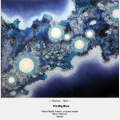Framing artwork is incredibly important and many artists consider it part of their final outcome – Francis Bacon demanded his canvases were framed behind glass, for instance. Despite the cost that framing can add to production costs, it might be something you consider and these 5 tips are here to help you on your way.

Framing adds professionalism (even if just offered as an option at the point of sale) and a framed work is much more likely to sell. Remember: if a potential buyer can imagine an artwork in their home, they are much more likely to buy it!
- Different artworks call for different types of frame. As a rule, small pieces need much thicker frames, preferably bevelled so they draw in the eye. Statement frames are personal preference and can put buyers off. If you are trying to sell works on paper, plain frames are better. When framing works on canvas, it is often better to leave it as there is more involved.
Image by Trevor Banthorpe via ArtWeb. - Matting. Everything within the frame belongs to the picture, the frame itself belongs to the room. This is a very good rule of thumb and this is why: matting (the spacer between both the work and the glass and the work and the frame) has nothing to do with the room it hangs in. Do not be tempted to match the matting to your wallpaper or the room’s colour scheme. Ideally the matting shouldn’t be darker than the artwork’s darkest colour, brighter than the brightest colour, bolder than the boldest colour, or a completely foreign colour. This is the reason why ivory is such a popular choice.
- Never let the picture (no matter the medium) touch the glass. Dirt, dust and moisture all damage works of art and adding a spacer (matting) reduces the chance of any long term damage to your beautiful framed work.
- Consider non-traditional or unconventional modes of framing and displaying. It might be better to work with reproductions first or this pointer may be better suited to artists who work in editions or with works on paper. If you are selling at a fair or you have a stall somewhere then clips are a really easy way to display works; magnets make small artworks, prints and photographs fit in with sentimental memories and personal snapshots.
- Where possible always go acid free. This is especially important for matting as it stops easily preventable damage and discolouration. It is easily available from most art supply stores and, of course, online.
Framing is an art in itself and there are many courses that people go on to learn the trade. That isn’t to say you can’t give it a go as a project and as a way to give your artwork a little something extra. If you want a higher quality finish, have a look around and scope out the craftsmanship at your local framers, this will also give you a good indication of the glass options out there and different finishes you might want to consider.
There are loads of places to pick up frames: reusing them with differently sized mattings, charity shops, online auctions, and of course, frame retailers.
Now that you know some basics, your work could stand a much better chance of standing out and making a small step toward a big sale.








